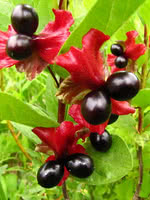Mon-Fri 9am - 5pm Mountain time
Common Snowberry vs Bracted Honeysuckle
Symphoricarpos albus
Lonicera involucrata
NOT AVAILABLE THIS SEASON - MIGHT RETURN
Common Snowberry is a small deciduous shrub with characteristic white to pink flowers and clusters of white fruit.
This North American native species is very adaptable, and can be used for erosion control in riparian and restoration areas. Snowberry's fruit attracts wildlife, and livestock can consume the berries without issue.
Bracted Honeysuckle is a shade loving shrub that is distinguishable from other honeysuckles by its square stem and pointed leaves. Native to most of North America, this honeysuckle is found along swamps, rivers, riparian zones and moist wooded areas.
If you have a erosion control project in mind, consider Bracted Honeysuckle.
Common Snowberry Quick Facts
Bracted Honeysuckle Quick Facts
Toxicity: berries toxic to humans

